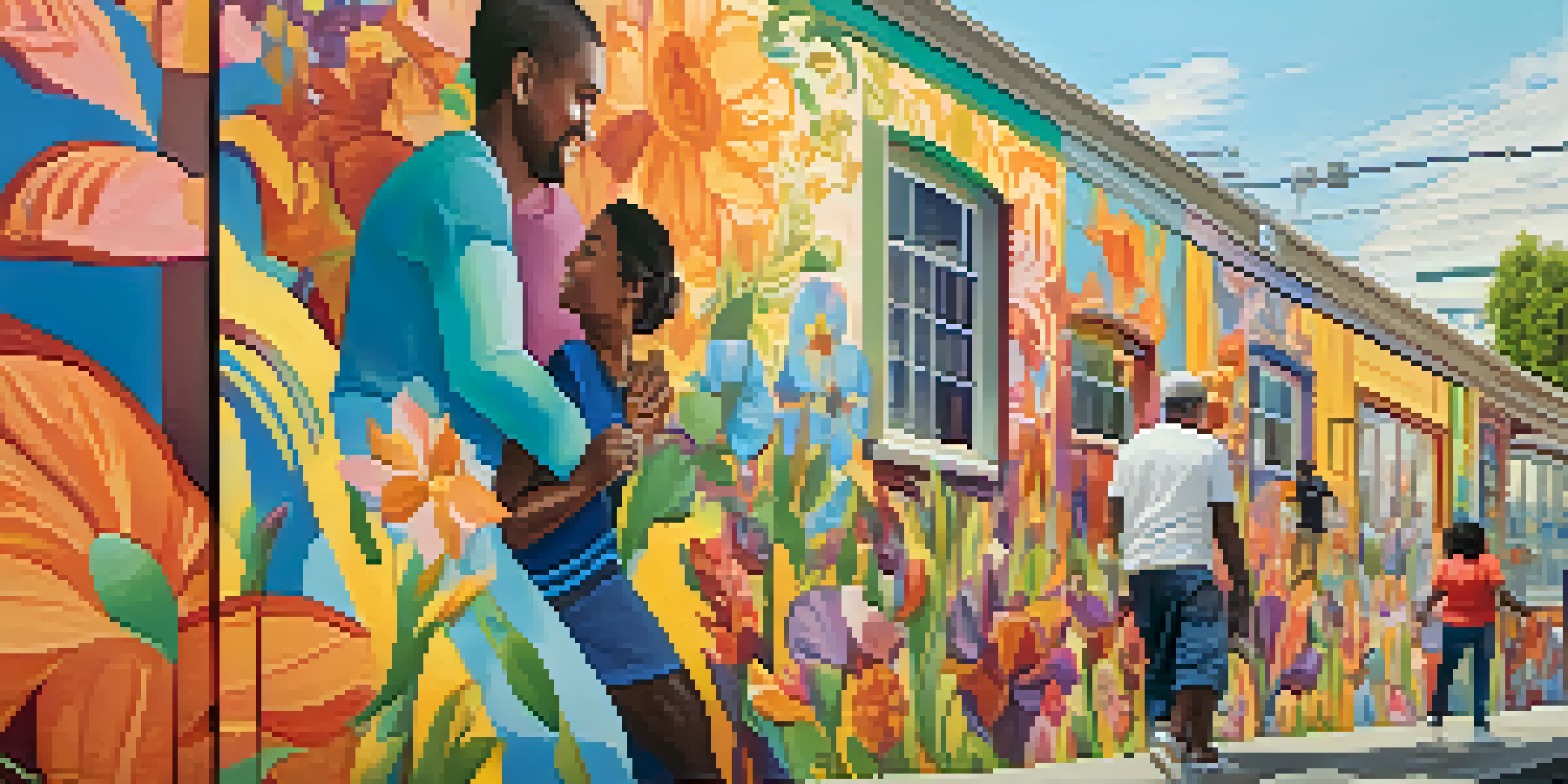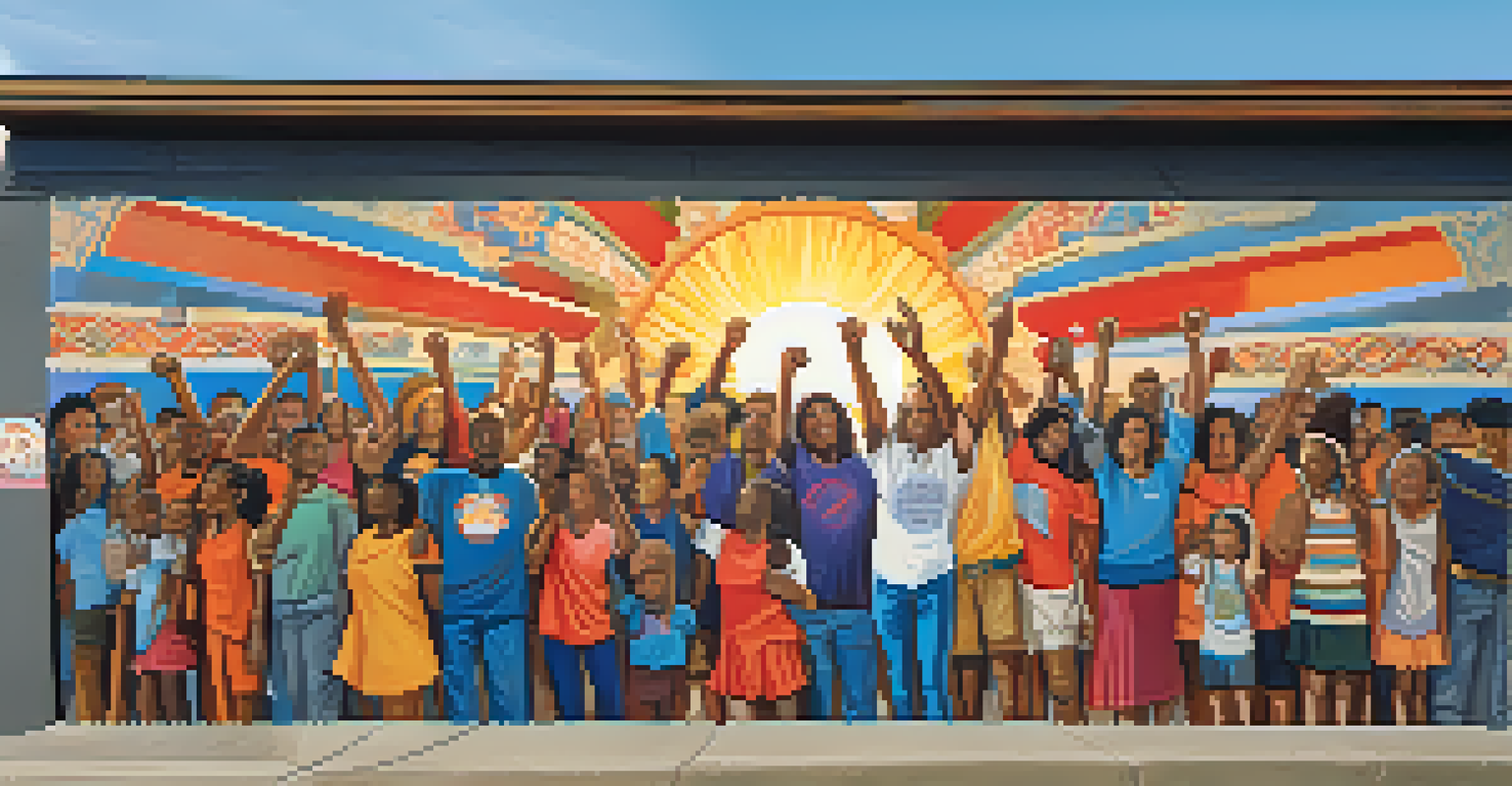Street Art: A Canvas for Urban Cultural Identity and Issues

Understanding Street Art as a Cultural Expression
Street art has evolved from simple graffiti to a vibrant form of expression that reflects the culture of urban environments. Artists use this medium to convey messages about identity, community, and social issues, often blending personal narratives with broader themes. In many ways, street art serves as a visual diary of a city, showcasing the voices and experiences of its inhabitants.
Art is not a mirror held up to reality, but a hammer with which to shape it.
Consider the murals in cities like Berlin, which tell stories of history, resilience, and change. Each piece is not just art; it’s a conversation starter, inviting viewers to engage with the culture around them. By understanding the context behind these artworks, we can appreciate their significance in narrating urban life.
Furthermore, street art often challenges traditional notions of where art belongs. When it appears on the streets, it democratizes access to art, making it available to anyone who passes by, rather than just those who visit galleries. This accessibility fosters a shared cultural identity among diverse communities.
The Role of Street Art in Addressing Social Issues
Street art frequently highlights pressing social issues, acting as a form of protest or awareness campaign. Artists tackle topics such as inequality, environmental concerns, and political unrest through their work. For example, the powerful murals during the Black Lives Matter movement have brought attention to racial injustice and sparked important conversations.

These artworks often serve as a reflection of the community's struggles and aspirations, providing a space for dialogue. When a piece of street art resonates with a local issue, it can inspire action and solidarity among residents. This connection between art and activism is what makes street art a potent tool for social change.
Street Art as Cultural Dialogue
Street art serves as a visual diary that reflects urban culture, identity, and social issues, inviting community engagement.
Additionally, street art can provoke thought and encourage viewers to reconsider their perspectives. By forcing people to confront uncomfortable truths, artists create an opportunity for reflection and growth, reinforcing the idea that art has the power to influence society.
Street Art: A Voice for Marginalized Communities
Many street artists come from marginalized backgrounds, using their art to express their unique experiences and challenges. This form of expression allows them to reclaim public spaces and assert their identity in a world that often overlooks them. By painting murals that reflect their stories, these artists bring visibility to issues faced by their communities.
The role of the artist is to make the revolution irresistible.
For instance, the work of Indigenous artists in urban spaces has transformed blank walls into canvases that celebrate their heritage and advocate for rights. These pieces not only educate the public but also foster pride within the community, reinforcing cultural identity.
Moreover, street art can serve as a unifying force for marginalized groups. By collaborating on large-scale murals, artists can create a shared narrative that resonates with their collective experiences, promoting solidarity and community engagement.
The Impact of Street Art on Urban Landscapes
Street art has the remarkable ability to transform urban landscapes, turning dull spaces into vibrant galleries. A once-neglected wall can become a canvas that breathes life into a neighborhood, attracting visitors and boosting local economies. This transformation often leads to revitalization efforts that benefit the entire community.
Cities like Melbourne and Lisbon have embraced street art as a means to enhance their cultural appeal. By recognizing the importance of these artworks, local governments can foster an environment that celebrates creativity and innovation. This, in turn, can lead to increased tourism and community pride.
Art as Activism for Social Change
Street art often highlights social issues and inspires action, making it a powerful tool for community dialogue and activism.
However, the impact of street art is not always universally positive. Gentrification can arise when art is used to market neighborhoods, leading to the displacement of long-time residents. Balancing artistic expression with community needs is essential to ensure that street art serves as a catalyst for positive change.
The Evolution of Street Art in the Digital Age
The rise of social media has significantly influenced the evolution of street art, allowing artists to share their work with a global audience. Platforms like Instagram have transformed how art is consumed, making it easier for artists to gain recognition and connect with fans. This digital exposure can amplify the messages behind their work, reaching beyond local communities.
Additionally, the digital age has fostered a new generation of street artists who blend traditional techniques with digital tools. Augmented reality and interactive installations are becoming more common, creating immersive experiences that engage viewers in unique ways. This merging of technology and art opens up exciting possibilities for storytelling.
However, the accessibility of digital platforms also raises questions about authenticity and ownership. As street art gains popularity online, artists must navigate the fine line between sharing their work and protecting their creative rights. This ongoing dialogue reflects the dynamic nature of street art in contemporary society.
Street Art and Community Engagement
Street art fosters community engagement by inviting collaboration and participation from residents. Many artists involve local community members in the creation process, ensuring that their work reflects the voices of those who live there. This collaborative approach not only strengthens community bonds but also empowers individuals to take pride in their environment.
For example, community mural projects often bring together diverse groups to address shared goals and aspirations. When people come together to create something beautiful, it can spark a sense of ownership and responsibility for their surroundings. This collaborative spirit is essential in building resilient communities.
Community Engagement Through Art
Collaborative street art projects empower communities, fostering pride and ownership while educating residents about local history and culture.
Moreover, street art can serve as a platform for education and awareness. Workshops and events surrounding mural projects can promote discussions about local history, culture, and social issues, further enriching the community's understanding of its identity. Through these initiatives, street art becomes more than just decoration—it’s a tool for empowerment.
Challenges Facing Street Artists Today
Despite its many benefits, street art faces several challenges in today's urban environment. Legal issues often arise, as many artists work on public property without permission, risking fines or arrest. This precarious situation can deter some artists from expressing themselves freely, limiting the potential of street art as a cultural commentary.
Additionally, the commercialization of street art can dilute its original intent. As neighborhoods gentrify, the art that once reflected community struggles can become commodified, losing its significance. This shift can create tension between artists and developers, as the essence of street art is rooted in authenticity and resistance.

Finally, the battle for recognition and respect continues for many street artists. While some have successfully transitioned to galleries and exhibitions, others still struggle to be taken seriously in the art world. Advocating for street art as a legitimate form of artistic expression is crucial for preserving its cultural relevance.